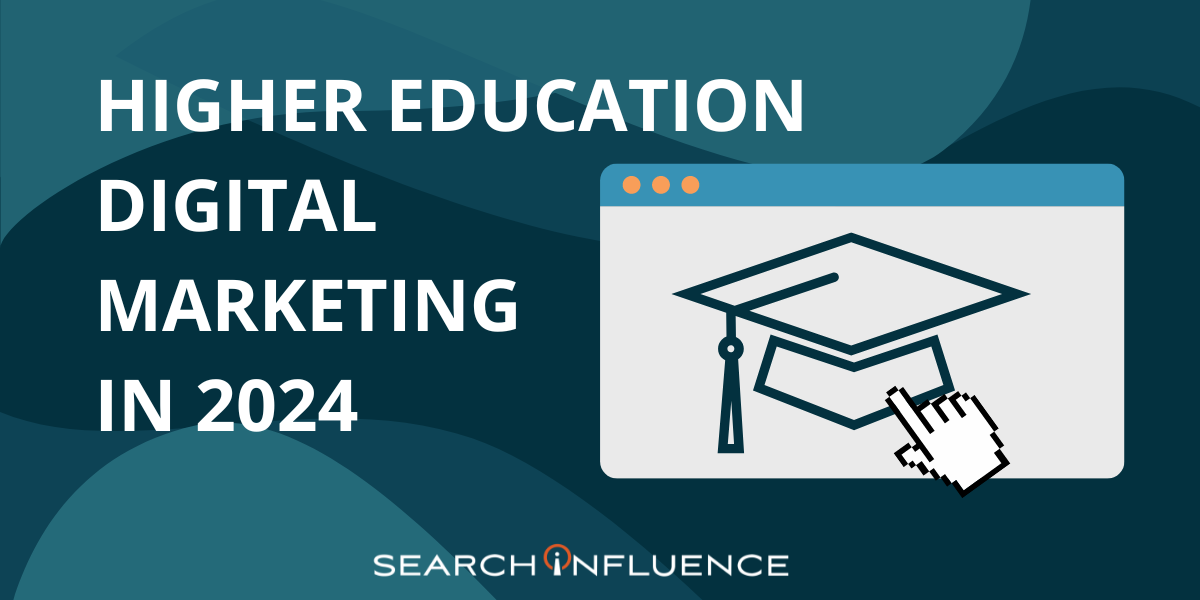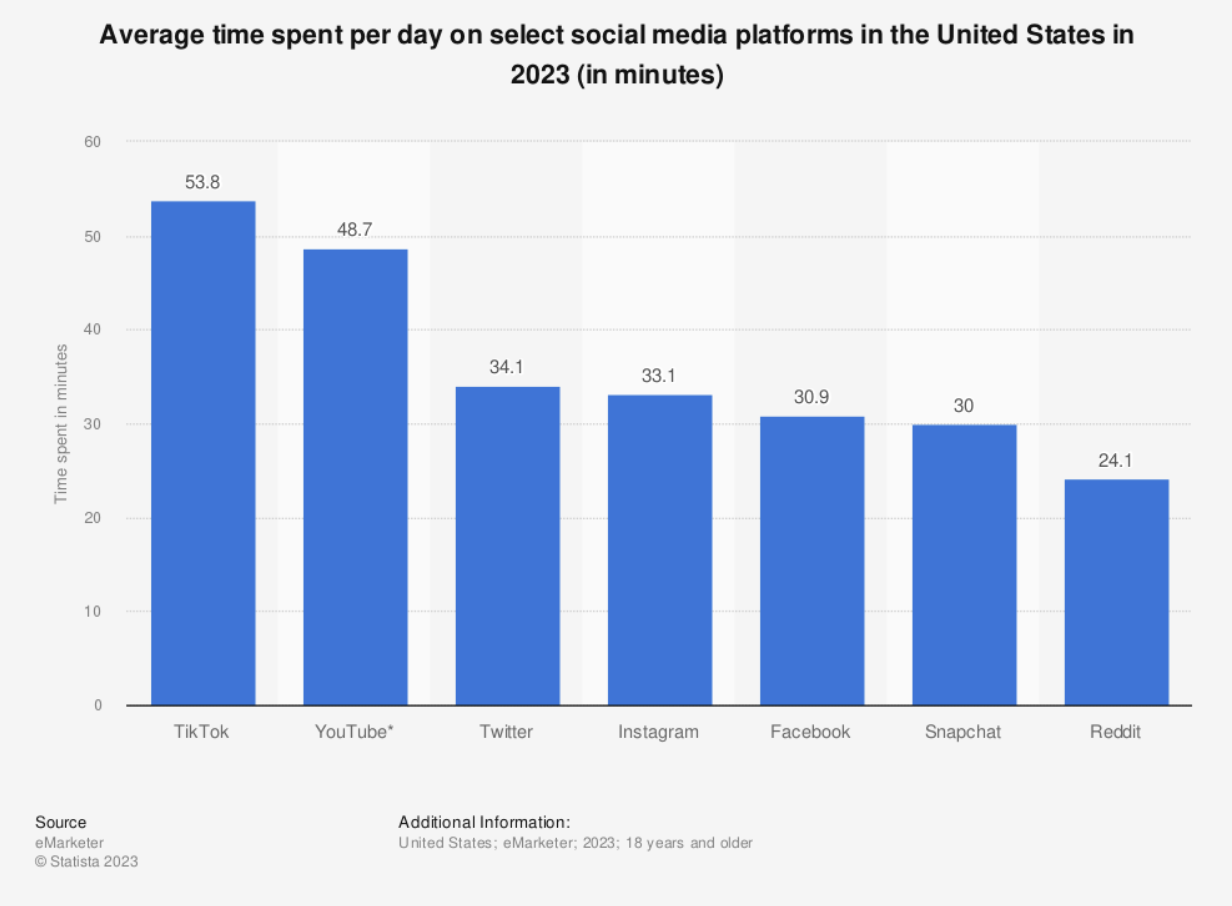Higher Education Digital Marketing – Your Key to Growth In 2024
March 19th, 2024 by
Imagine you’re a ship captain embarking on a voyage in uncharted waters. That’s what it’s like navigating the ever-changing currents of Higher Education Digital Marketing.

As the deck shifts beneath you, you are steering your institution’s ship through the waves of change – hopefully toward improved enrollment and a better return on investment (ROI.)
Mobile devices, social media, and the need to show value with data analytics are critical in your marketing efforts to attract, engage, and retain students.
As we go deeper, you’ll learn to master the art of marketing in higher education, turning challenges into opportunities and ensuring your ship doesn’t just stay afloat but sails triumphantly toward the horizon of success.
Digital Marketing Strategy – What’s Working?
For a more comprehensive look at what other schools and their agencies are thinking about for lead generation. Have a look at our blog roundup: 10 Winning Higher Education Marketing Strategies.
Top 10 Higher Education Digital Marketing Strategies
- SEO (Search Engine Optimization)
- Paid Advertising (PPC, Pay-Per-Click, Display and More)
- Content Marketing
- Email Marketing
- Social Media Marketing
- Video Content
- Personalization
- Branding
- Chatbots and Conversational Marketing
- Data-Driven Strategy
SEO: The Key to Visibility
SEO is essential in your institution’s visibility online, bringing high-quality content to the forefront and establishing your authority. It’s a cornerstone of higher education marketing, offering a way to increase search engine rankings and maximize organic traffic.
Good SEO is simple, not easy.
In short, SEO is about relevance and authority. Or, another way, keywords, content, and links.
An academic research paper is judged over time by the number of citations it receives, and your website is judged by the number of links, references, and citations, too.
Keyword Research Is Changing
As Internet search engines move from “lexical” to “semantic” search, it is that much more important to create connections in a semantically relevant way. Keywords (or search terms) are still important, but equally important are the entities they represent.
Hint: look for bolded text in this article. Most are entities – either Wikipedia or Google NLP. Some are just for emphasis.
Consider the humble Hoagie. You don’t know what a hoagie is? It’s what people in Philly call a Sub or Hero. In New Orleans, we call it a Po-Boy.
To Wikipedia, however, Sub, Hoagie, Grinder, and others are the semantic equivalent of “Submarine sandwich.”
Constructivist learning theory suggests learners construct knowledge by integrating new information with existing knowledge and experiences. Search is like that.
There are far too many “keywords” for search engines to catalog them all, and they must, therefore, index those keywords to known entities.
A fun aside: Po’ boy gets its own Wikipedia page.
Link Building Is Hard
The good news for you, if you’re marketing higher ed institutions, is that most of your websites are very authoritative. They already have a lot of external links, and they get a lot of organic usage.

In the SEO community, we’ve long believed that user signals, i.e., the way a visitor interacts with your website, are important. With students and other community members using your website as a resource, you can be assured that your user signals demonstrate engagement.
But is it easy for them to find what they need? And if you were a search engine crawling your own website, would it be easy to navigate among related topics?
When the World Wide Web first launched, hyperlinks were a radical departure. The idea we could jump from one document or passage to another was revolutionary.
Site visitors want to move seamlessly from one idea to the next and from one page to another, as well. Search engines do, too.
Chances are you don’t have enough internal links within the content of your website. If you want the search engines to really understand the relationship between areas of your site, you need to demonstrate those connections with links.
Hopefully, your content management system supports easy internal linking. If you use WordPress, we’ve been enjoying the plugin LinkWhisper which automates much of the internal linking process.
Does this mean you don’t need external links? Not at all, but you get to be more selective.
Are you launching a new program? Highlighting a student or faculty story? These may need external links to get found, and those can be in the form of PR, social media, and other organic behaviors.
Embrace Your Technical Side
If your website doesn’t function properly, users and search engines will not be able to find what you want them to.

A broken website is obvious, but there are less obvious technical implementations that can add tremendous value:
- Website load speed
- Readability (important for accessibility as well)
- Image size and format (relates to load speed)
- Structured data
A typical “SEO Audit” will highlight a number of irrelevant issues, like HTML code compliance, for instance. Today, however, having a fast, easy-to-read site that loads well on mobile devices and feeds the engine semantically relevant information is the starting point.
Technical SEO doesn’t have to be scary if you focus on the handful of things that really matter.
Paid Advertising: Extend Your University Marketing
Search engines are attacking your organic search efforts on multiple fronts which makes online advertising that much more critical.
The integration of AI results means your organic content is further down the search engine results page (SERP.)
New social channels, like TikTok, Instagram, and Snapchat, are being used by the coming generations in place of search engines.

PPC, Pay-Per-Click, and Search Ads
You are likely familiar with paid search ads. They are one of the oldest forms of Internet advertising, dating back to the last century.
They have come a long way. In the beginning, they matched ads to what a user searched for. Now, they can include multiple layers of targeting.
In addition to the searched words, we can now layer demographics, searcher intent, and even retargeting. The humble search ad started as a sledgehammer and is now a laser-guided surgical instrument.
With pay-per-click, you only pay when someone clicks your ad, making it a good way to manage budget and ROI.
Digital Display Advertising
Closely related to search advertising and often available in the same systems are digital display ads.
Many channels have options for display advertising, including the Google Display Network and Meta (parent of Facebook and Instagram).
There are also specialized advertising platforms that allow digital ads to be targeted based on third-party data. These can be subscribers to various services, demographics, or affinity, and in-market data.
Social Media Advertising for Higher Ed

Each platform has paid ads available. In addition to PPC and Display, there are platform specific options such as InMail on LinkedIn.
When these advertisements are native to the platform, they often provide a better response rate.
Television and Connected Devices DTV/CTV/OTT
As in-home entertainment moves more asynchronous and digital, you can now reach prospects with digital advertising during leisure activities.
These platforms share the audience targeting capabilities of digital display.
Retargeting and Remarketing
Each time a web searcher is exposed to messaging online, whether news sites, entertainment, or in the social media space, they become an opportunity for retargeting.
You can target visitors to your website, those who’ve seen other ads or a specific landing page, and even by email and phone number. These technologies are available in most paid campaigns, even your existing Google ads.
Whether you like it or not, if you want to reach your target market, you will sometimes need to pay for it.
Content Marketing Drives Engagement
At its best, content marketing is a storytelling opportunity. Regardless of the medium, you have an opportunity to engage your audience in entertaining and informative ways.

Showcase your institution’s unique values, tell your story, and present your offerings in a way that appeals to your prospective students.
Current students, campus life, and your degree program are all great topics. Your blog and video content allows for student-centered content with an integrated call to action for relevant leads.
As higher education marketers, we have to wear a number of hats. Yes, we need to increase search engine visibility. And lead generation has to be a major focus of any marketing campaign focused on new students. But we also have to serve our faculty and administrators.
The great news is our faculty are prolific content creators in their own right.
This frees us from having to build brand awareness with new content. We can optimize existing content from our college website and degree programs to reach the prospective student.
Content comes in many forms. Just as we can leverage the university website to get in front of prospects, we can take advantage of admissions materials like video campus tours to increase our university’s brand visibility.
The smart marketer is making more with less. Any existing content that is supportive of your school’s brand is ripe for reuse.
With new AI tools, we can even take a web page and turn it into a short-form video, social media posts, or pretty much anything we can dream up.
Video content is particularly powerful in higher ed marketing, as it offers an engaging, dynamic way to showcase your institution and its offerings.
But there are nearly endless ways to get your university noticed with content. Here’s a list to get you thinking:
Written Content
- Blogs
- Articles
- E-books
- White Papers
- Case Studies
- Newsletters
- Infographics
- Press Releases
- Guides and How-To’s
- Checklists and Cheat Sheets
Visual Content
- Images
- Videos
- Webinars
- Slideshows and Presentations
- Live Streaming
- Virtual Reality (VR) and Augmented Reality (AR)
Audio Content
- Podcasts
- Audiobooks
Social Media
- Snapchat
- TikTok
Interactive Content
- Quizzes and Polls
- Interactive Infographics
- Online Courses and Workshops
- Games and Interactive Experiences
Hopefully, this shows that there are tons of ways to get in front of your audience, and in many cases, adapt existing material to new channels to do so.
Effective Email Marketing
There are three distinct types of email marketing every school or business unit should be engaged in.

- Outbound or cold email
- Nurture sequences (including email, SMS, social media)
- Newsletter
Outbound Email Marketing For Higher Ed
The biggest challenge in lead generation is getting your school’s brand in front of a ready audience.
Done well, outbound email opens up new audiences for your degree programs you might not reach otherwise.
There are platforms focused on college students in various stages of decision-making.
And, with email lists, you can access demographic data that is no longer available on traditional advertising platforms.
Just like direct mail of old, email is a great way to test messaging and calls to action and to get a quick response.
Nurture And Followup Email
What a shame it would be for you to spend time, money, or both getting interested students to your web pages or landing page and then not following up. And if they’re getting there and not taking action you may want to consider conversion optimization.
We help our clients build nurture sequences in HubSpot, Slate, and other customer relationship management systems (CRM), which include email, SMS, and social media contacts as well.
The higher education buying cycle can be long, and it pays to stay in front of your prospects throughout that time.
You can use nurture sequences to stay in front of your target audience, share valuable information, answer questions, and share the perspectives of current students.
And email nurture is good customer service, too.
Newsletters
Newsletters are a great way to stay in front of your audience and communicate important news and events, even when they’re not actively engaged in a marketing campaign.
For effective email:
- Personalize: Use the recipient’s name and tailor content to their interests or actions.
- Segment: Target groups based on course of interest, geography, and more.
- Make Them Compelling: These are your first impressions. Make them count.
Invest time in crafting thoughtful, relevant emails. Your prospective students deserve it, and your enrollment numbers will thank you.
Social Media for Brand Awareness

Harnessing the power of social media can significantly boost your institution’s brand awareness and forge stronger connections with potential students.
By using popular social media platforms like TikTok, Instagram, LinkedIn, and Facebook, higher education institutions can effectively reach and engage their target audience.
Sharing engaging content such as videos, experiences, and university events on these platforms can elevate your brand and increase its visibility. You’re not just marketing your institution; you’re building a community where students feel heard, seen, and valued.
Consider platforms like YouTube and TikTok for sharing engaging video content. These platforms can significantly improve your reach and brand awareness.
Influencer marketing can significantly increase brand visibility and foster trust with potential students. Consider your own students, some may be micro-influencers in your community.
In addition to organic engagement, social media sites offer significant advertising opportunities.
Video Marketing: A Powerful Tool

YouTube is the second most used search engine.
TikTok and Youtube — video sites — earn around 50 minutes/day of users time and attention.
This is significantly more than any other platform.

And, in each case, the platform algorithms are tuned toward engagement.
Platforms like YouTube and TikTok are perfect for sharing short videos that showcase your university’s programs and lifestyle. These bite-sized pieces of content often result in better engagement and can be easily shared across various social media platforms.
Consider crafting virtual tours of your campus facilities. Prospective students can experience your institution from the comfort of their homes, making it a unique selling point in your higher education marketing strategy.
Additionally, you can link these short videos to longer, more detailed ones for additional information and engagement.
Analytics & Reporting: Show Me The Money

Analytics and reporting are an absolute must if you want to demonstrate your value.
In our practice, we talk about analysis, tracking, and reporting ATR for short. We use that language for a couple of reasons. First, analytics is the brand of Google’s tracking system. More importantly, we believe that without analysis, the data is meaningless.
For many of our clients, lead generation and cost per lead (or cost per inquiry/CPI) are the most important metrics.
With every report, we’re making a case for our continued employment. In a recent UPCEA research study the data indicates that 62% of higher education institutional leaders want reporting on SEO metrics, but just 31% receive regular updates.
There are many ways to view Google search data and other metrics relevant to your higher education website.
Some of our favorites are:
- Google Analytics
- Google Search Console
- Google Business Profile
- Bing Webmaster Tools
- Advance Web Ranking
We bring all this, plus advertising and task data, together in custom reports built-in Google Looker Studio.
If you’re trying to decide if a topic is worth pursuing, you can also look at Google search trends.
It’s important to remember that any of these tools are directional, not exact. The numbers are always an estimate, and the best you can do is follow the trends.
Prospective Students Aren’t The Only Target Audience
Often, when we think of university marketing efforts, we think Generation Z enrollment. But there are many more constituencies to consider.
When we focus on high school students and the younger generation, we may overlook some channels that are more appropriate to some of these other audiences. Just because those high school students aren’t on Facebook doesn’t mean they’re not influenced and financed by someone who is.

Parents
At the undergraduate level, college marketing needs to consider parents in lead generation efforts.
Whether they are paying, guaranteeing a loan, or simply supporting their student, you want to think about parents. They will approach information differently than their students.
Community
It’s unlikely that your school is on an island. The community in which you live and work is an important target for your marketing campaigns.
Whether you are recruiting staff or simply trying to maintain a good reputation, your local community needs to know what is going on at your school.
Peer Organizations
Whether down the block or around the world, peer schools and organizations can be an important part of your efforts.
You may not be trying to fill a faculty position today, but you will.
Consider how you find “product” information. You ask someone who knows, and likely, your peers will be asked about you.
Existing Students
Our best prospect is a customer who’s already connected with us. Your existing students know who you are and, in many cases, are a captive audience on your campus.
One of our client schools has even used yard signs to reach prospective students for summer graduate programs on campus.
Your students are also uniquely qualified to create user-generated content that will be sure to resonate with prospects.
Faculty And Staff
Like some of these other examples, your employees can be some of your best ambassadors.
You may have the opportunity to double your return on effort if your marketing campaigns also support your internal communications.
Frequently Asked Questions

What Is the Role of Digital Marketing in Higher Education?
The role of digital marketing in higher education is growing. Prospective students and their influencers are turning to digital media first. Traditional media: publications, television, and radio are being overtaken by digital advertising.
Can You Do Digital Marketing to High School Students?
There are a number of platforms (TikTok, Snapchat, etc.) that are popular with high school students. You can also use programmatic advertising and email to target households likely to have high school students. You can also use professional sites like LinkedIn to target educators and counselors.
Which Type of Digital Marketing Is Best for Students?
The type of digital marketing that is best for student recruitment will depend on a number of factors. Are you targeting undergraduate, graduate, non-credit, community college, or something else?
There is no one-size-fits-all.
Who Does Marketing for Universities?
Marketing for universities is typically a combination of the internal marketing team, external agencies — specialized firms who bring expertise in areas like digital targeting, enrollment campaigns, branding, and faculty and students. Faculty, staff, student achievements, and campus life stories enable compelling content.
What Are the Functions of Marketing?
The functions of marketing are understanding customer needs and creating value. Research, develop, price, promote, deliver, nurture, and measure success. It’s all about connecting products with happy customers.
Conclusion
There are countless ways to approach higher education digital marketing. After 18 years in business, we understand the value of focus.
We specialize in search engine optimization and paid digital advertising because they’re the most reliable way to drive qualified inquiries and deliver a provable ROI.
By implementing a comprehensive Higher Education Marketing Strategy, you can effectively reach and engage your target audience, nurture leads, and ultimately attract new students.
By focusing on these key areas and tailoring your approach to your specific audience and goals, you can create Higher Education Digital Marketing Strategies that drive meaningful results.
The key is to focus on a student-centric approach, utilize a variety of digital marketing tools, and continuously measure and optimize your efforts for maximum ROI.
We hope this overview was useful. Some other areas you may want to spend time learning about are:
- Optimizing landing pages for paid search campaigns.
- Utilizing short-form video content for social media platforms like TikTok.
- Implementing conversational marketing strategies to engage with prospective students directly.
- Collaborating with student ambassadors to promote the university brand.
- Integrating voice search optimization into your content strategy.
We know it’s a lot. Search Influence has worked with higher education institutions for over a decade to attract prospective students. Get in touch and let’s see if we can help you, too.
This article was mostly written by Will Scott, CEO of Search Influence with a little help from the robots.

